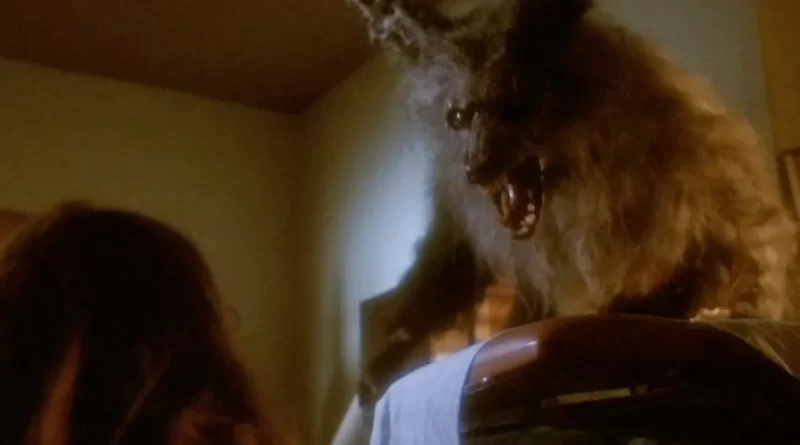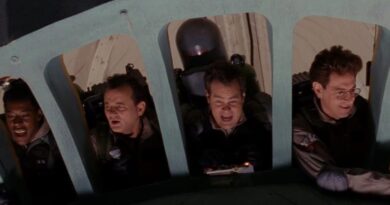The Howling (1981)
Having done man-eating mutant piranhas, perhaps werewolves were the next logical step for the cinematic journey of Joe Dante. If only it wasn’t a misstep – or rather, a major stumble and fall. The Howling is a real clunker. The premise is ridiculous. The performances fall somewhere between B-movie camp and mere bad acting. Perhaps worst of all, the makeup effects, though elaborate, are hopelessly unconvincing. If what we’re shown represents the latest and greatest in prosthetics and puppetry, we might as well go back to the painstaking process of progressive makeup applications and continuous camera dissolves, which Lon Chaney Jr. had to endure in all the Wolf Man films of the 1940s.
The fact that the film is unfaithful to Gary Brandner’s novel isn’t the issue. The issue is that John Sayles and Terence H. Winkless lowered the standards of storytelling with their screenplay. That’s really saying something, since the novel, entertaining as it was, hardly amounted to what one would call top-drawer material. It was no more or less than what it so obviously was. It told the story of a sexual assault survivor moving to a dead, middle-of-nowhere California mountain town with her husband in the hopes of recovering from her trauma; she eventually discovers that the locals are werewolf descendants of a cursed, centuries-old European village. There were no pretenses. It was a horror story, pure and simple.
The film makes attempts at subtext and satire; it’s about the dichotomy of human nature, the fact that monsters hide amongst us in plain sight, the dangers of cults and radical ideologies, and how the media can turn critical thinkers into jaded cynics. Giving the story meaning is in and of itself a great idea. The problem is that it’s done half-heartedly, and with little regard for the credibility good performances and strong direction add; in their human forms, the werewolf characters are directed to be third-tier parodies of the tenants in Rosemary’s Baby, ranging in typecast from perky young women to elderly curmudgeons to backwoods country bumpkins. The latter is especially evident with a guys-only hunting party and Slim Pickens as the local sheriff.
Dee Wallace plays Los Angeles TV news anchor Karen White, who has been receiving obsessive phone calls from a serial killer (Robert Picardo), whose apartment is a filthy shrine of newspaper clippings and his own pen-and-ink werewolf drawings. A sting operation in which she agrees to meet the killer at a pornographic book shop proves too traumatic for her to cope with. Anyone with a brain would know she should never have been subjected to this, not only because it would involve a dangerous police presence but also because she would be exploited on camera by her own news team. Anyway, at the advice of an English psychologist always eager to push his latest book on TV (Patrick Macnee), Karen and her husband Bill (Christopher Stone) travel to a seaside resort the doctor calls The Colony for largely undefined therapeutic treatments.
This brings us back to the aforementioned strange locals who are secretly werewolves – and no, I’m not giving anything away by saying that, lest you thought the title was in reference to something else. Anyway, one of the locals is a sultry raven-haired nymphomaniac (Elisabeth Brooks), who even in her human state keeps her animal side at the forefront; pelts are nailed to the outside walls of her rustic cabin and bones hang on the porch like wind chimes, she dresses in all black with a necklace made of canine teeth, and she goes after the very weak Bill with the tact of, as Karen correctly states, “a bitch in heat.” Indeed, it takes almost no time for the two to strip completely naked by a campfire and have the kind of sex that literally turns animalistic.
Aside from an inconsequential subplot involving Karen’s work colleagues (Belinda Balaski and Dennis Dugan) delving into lycanthropic investigative work, there’s really nothing more about the story that bears mentioning. So let’s focus on the performances. Dante has been nothing if not consistent in his love of B-movies, and thus far, that’s always reflected in how he directs his actors. Since this is a horror movie presumably made with the intention of frightening audiences, that proves to be the wrong approach. Example: Wallace is able to wake up from a nightmare screaming and crying, but when in front of a man transforming into a werewolf, she stands there stoically and just stares – allowing for the transformation to drag on and on and on.
That wouldn’t have been a problem had the special effects by Rob Bottin been any good. Watching the transformation scenes, there’s never a moment when we’re not aware that air bladders are hidden under foam rubber prosthetics, or that stretching muzzles are just animatronics covered in latex. When they’re done transforming, it’s obvious that they’re just actors on stilts wearing furry suits. As cheesy as it sounds, The Howling made me howl in disappointment. The only thing I got out of it was Dante’s trademark of finding small roles for Dick Miller and Kevin McCarthy (though not Paul Bartel, surprisingly). This time, he even works in a cameo for his mentor, filmmaker Roger Corman.




